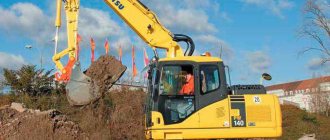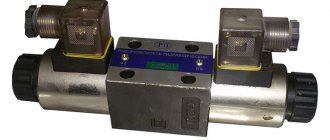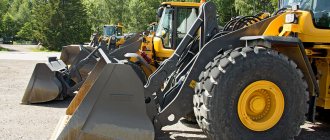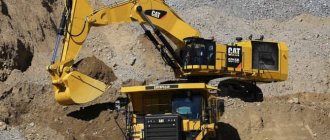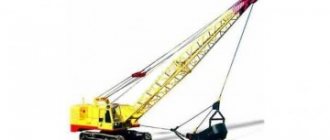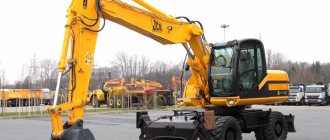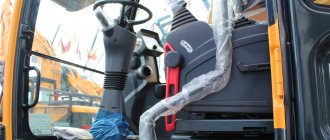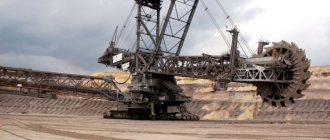In any era, excavation work was not only the most necessary, but also the most labor-intensive. Therefore, since ancient times, many people have thought about how to make this hard work easier and speed up the process.
One of the first was Archimedes. He designed many useful devices, including machines with buckets designed for digging soil. The Roman conquerors called them excavators (Latin Excavao - to make a deepening, to hollow).
How did excavators appear?
In the era of Leonardo da Vinci, the use of excavators was commonplace, but then completely simple earth-moving machines were used, which were vaguely reminiscent of the first analogues of this device. In the first half of the century before last, the first ancestors of the excavator appeared, which were necessary for the construction of railways. These machines were used in clearing canals and fortification work. The buckets were powered by the muscular power of people or animals. In the East, they learned about excavators from Marco Polo. He told the Chinese emperor about the miracle technology, for which he was awarded special favor.
In the middle of the 19th century, mechanical, or rather steam, engines appeared on excavators. The first such machine was designed in the USA in 1843 by engineer James Otis, who was a direct descendant of one of the “fathers of the nation” during the Civil War. An excavator with a 15-horsepower engine removed 40 - 50 cubic meters of soil in an hour. Even by modern standards, this is not bad at all! He replaced fifty diggers. One of the first models, quite damaged, can still be seen in the museum.
The first excavators with steam engines worked on world-famous construction sites - in Egypt, on the construction of the Suez Canal, and in Russia, on the Nikolaevskaya Railway. True, domestic officials were not too happy about the mechanization of labor. Using serfs and prisoners was much cheaper. In 1848, all 4 “Nikolaev” excavators were sold to the Demidovs. Enterprising businessmen supplied the machines to stripping operations, where they proved to be very effective.
Important
After Otis excavators appeared in the Urals, heavy engineering began to develop there.
The word excavator was taken from the Latin language and can be literally translated as a chiseling technique. This is an earthmoving machine that allows you to remove and develop soil. Ground surfaces can be either soft or rocky, there are no restrictions.
Excavators on a car chassis:
The base of single-bucket excavators on a car chassis is an off-road truck, which has the ability to move freely on any type of roads or in their absence (off-road). Trucks are capable of traveling long distances in a short time.
The scope of application of such an excavator: as a rule, for medium-scale earthmoving work (cleaning reservoirs, canals, construction and repair of road surfaces, highways, etc.), and when changing working equipment (from a bucket to another) - also for construction and construction work. work, warehousing, delivery and movement of goods.
The main working equipment in most cases is a backhoe with a bucket with a volume of 0.04 to 1.5 m3. Less common are models where there is a transition from a straight shovel to a backhoe due to the presence of a rotating bucket and a telescopic boom. Some models can be equipped with replaceable working equipment: grab, load forks, hook, hydraulic hammer.
The following motors can act as propulsion machines:
- directly to the base vehicle;
- separate motors mounted on a turntable.
Excavator classification
There are many different classifications of excavators, depending on the criteria by which the equipment is graded. In this case, the same machine can be present in different lists.
- Non-standard excavators: review of models and prices
By application:
- self-propelled – have their own base chassis for moving to an object.
- semi-self-propelled - move only short distances in the work area.
- limited self-propelled - to move within the working area they require special paths, for example, rails.
You can rent an excavator based on the type of undercarriage:
- tracked – they are characterized by increased maneuverability and stability; for work on soft soils, tracks with an increased supporting surface are installed;
- pneumatic - such machines have high maneuverability and can independently reach the work site;
- on an automobile-type chassis - this special equipment is distinguished by a more powerful engine, increased transport speed, and a durable frame with a low center of gravity;
- on a production truck;
- on a serial (usually wheeled) tractor;
- rail;
- walking.
By main engine type:
- diesel;
- electrical;
- carburetor;
- steam.
Currently, mainly diesel and electric engines are installed on excavators, as they are the most economical. Diesel engines are used in conditions of periodic change of place of work. Electric ones are used on machines operating at a permanent location (in a quarry). By number of engines:
- single-engine - all excavator mechanisms are driven by one motor, or several that drive one shaft;
- multi-engine - each mechanism or unit has its own engine.
By purpose:
- Construction-universal. In this group you can remove an excavator with a bucket with a capacity of up to 3 m3. Used for excavation work.
- Career. They work with buckets with a capacity of 2 – 8 m3. Designed for the development of deposits in quarries.
- Overburden. They have buckets with a capacity of 6 m3. Used to remove the top layers of rocks.
- Special. These include underground, tunnel, peat, underwater, destroyers, rescue, swamp, and railway.
According to the execution of the working body:
- with a flexible suspension - the boom (and in some cases the bucket) is suspended on steel ropes and is activated with their help;
- with rigid suspension - all elements of the working equipment are in a hinged connection with each other; Hydraulic cylinders are used for actuation.
- with telescopic equipment - work is carried out by extending and retracting the boom.
By boom rotation angle:
- Full rotation (360 degrees).
- Partial rotation (less than 360 degrees).
By type of work cycle:
- Cyclic - single-bucket.
- Continuous action - trench with a toothed chain, with a frontal cylindrical or disk cutter, multi-bucket rotary.
By type of bucket drive:
- Mechanical ones are almost never used.
- Hydraulic - the most common.
- Electric - powered by power lines, extra heavy.
- Diesel-electric – autonomous heavy and especially heavy.
By chassis type:
- Pneumatic wheels - on an original wheeled chassis.
- Tracked - the same, on a tracked one.
- Mounted - on a serial automobile or tractor, tracked or wheeled chassis.
- Rolling rinks and ski mobiles (not currently used).
- Walking.
- Floating – bucket, loosening, grab or airlift dredges.
- Rail - quarry, port excavators, cranes and railway.
- Underground - they work in mines to reload cut rock. They can be combined with a shield into a roadheader.
313D2L
Crawler excavators of this model have a useful power of 68 kW and a weight of 13.7 tons. They are distinguished by improved control, high versatility, have a comfortable modernized cabin and are easy to operate. This set of characteristics allowed the 313D2L excavators to become leaders in their class.
The machines are equipped with efficient, powerful Cat C4.4 engines, which, due to a mechanical governor, reduce fuel costs by 14% compared to similar models. At the same time, digging and lifting efforts remain at the same high level. The engine operates stably even when fueled with fuel of poor quality, which is due to low pressure in the fuel supply system. Users have access to a wide range of attachments, which allows them to adapt the excavator to perform various tasks.
Bucket excavators, table
Single-bucket excavators, being the most numerous and widespread, are produced in a wide variety. Therefore, they have several “own” classifications.
By size group:
| Size group | bucket volume, cubic/m | power, l/s | weight, tons |
| “0” - especially light | up to 0.1 | 10-40 | until 3 |
| "1" - easy-1 | 0,15-4 | 30-50 | 5-6 |
| "2" - easy-2 | 0,25-0,6 | 40-60 | 8-9 |
| "3" - average-1 | 0,3-1,0 | 50-80 | 10-12 |
| "4" - average-2 | 0,65-1,6 | 80-130 | 19-30 |
| "5" - heavy-1 | 1,2-2,5 | 100-200 | 30-40 |
| "6" - heavy-2 | 1,6-4,0 | 200-350 | 55-60 |
| “7” - especially heavy-1 | 2,5-8 | 300-500 | 80-100 |
| “8” - especially heavy-2 | 5,0-10,0 | 400-800 | 100-160 |
Excavators weighing more than 8 tons are classified as super-heavy. They are designed according to individual specifications.
By type of structure supporting the bucket:
- The breaking boom is the most popular on universal machines and is driven by hydraulics.
- The articulated boom is heavy and bulky, but mobile and durable. Suitable for vehicles of size group 5 and above. This is exactly what was on Otis' excavator.
- Telescopic boom - works in the same way as a truck crane boom. It is used on excavators only in cases where greater structural rigidity is required.
- The swinging mast is an openwork, but quite rigid system. Usually a bucket is attached to it on cables. It drags along the ground and also topples with the help of cables. This is a dragline, used on quarry mining or overburden walking excavators. On floating machines or backhoe loaders, a grab can be suspended from such a mast.
By type of working body:
- Bucket - digs into the ground, often made with a hinged bottom.
- A forward or backhoe bucket scoops up soil.
- Grab - lowers onto the ground from above, slams shut and grabs it.
- Box (transfer bucket) – picks up loosened soil.
M320D2
This is a 124kW wheeled excavator that combines speed, versatility and productivity. It is capable of functioning on any surface, including various types of soil and road surfaces. Users have access to a wide range of attachments to solve various construction and production tasks. Operating the M320D2 machine is convenient and easy, as it is implemented using the ProductLinkTM system.
By reducing the duration of work cycles and increasing the forces on the handle and bucket, the productivity of the excavator was increased. All service points are accessible from the surface of the earth, which simplifies and speeds up the necessary repair or preventative operations. All important components are efficiently processed by a centralized lubricant supply system. The cabin is designed to provide maximum safety and comfort.
Common excavator models, table
| Model | excavator type | power of the power plant, kW | maximum reach when digging | volume of excavator equipment, m3 | characteristics of the breakout force on the bucket, kN | maximum unloading height, m | operating weight indicator, t |
| TVEX TVEX 140W | to olesny | 90 | 0,5-0,8 | 14,4 | |||
| TVEX ET-16 | crawler | 90 | 0,4-0,65 | 15,3 | |||
| Uralvagonzavod EO-5126 | wheeled | 150 | 1,42 | 32 | |||
| Uralvagonzavod EO-33211A | wheeled | 150 | 0,85 | 18 | |||
| Eksmash E140W | wheeled | 91 | 0,8 | 13,5 | |||
| Case CX130B | crawler | 70,9 | 8,31 | 0,8 | 6,39 | ||
| Case CX290B | crawler | 154 | 10,67 | 1,7 | 7,099 | ||
| Case W125 | wheeled | 84 | 9,08 | 0,57 | 6,51 | ||
| Case W185 | wheeled | 118 | 9,2 | 1,05 | 6,6 | ||
| Volvo EW 140 | wheeled | 76,5 | 9 | 0,75 | 12,8-15,2 | ||
| Volvo EW 170 | wheeled | 118 | 9,6 | 0,94 | 125,4 | 15-18,1 | |
| Volvo EW 210C | wheeled | 120 | 0,9-1,1 | 124,2 | 10,1 | 19,9-22,2 | |
| Volvo EW 140C | wheeled | 91 | 9,3 | 0,94 | 89,5 | 14,4-15,8 | |
| Volvo EW 140B | wheeled | 92 | 8,4 | 0,75 | 15,4 | ||
| Hitachi EX 125WD | wheeled | 107 | 7,8 | 0,19-0,5 | 12,2 | ||
| Hitachi EX 100WD | wheeled | 81 | 7,7 | 0,19-0,59 | 10,6 | ||
| Hitachi ZAXIS 180W | wheeled | 90,2 | 9,5 | 0,7 | 18,6 | ||
| Hitachi ZAXIS 160W | wheeled | 90,2 | 9 | 0,6 | 85 | 6,35 | 15,7 |
| Hitachi ZX 140W | wheeled | 90,2 | 5,77 | 0,6 | 99 | 16,5 | |
| Hyundai R 140W-9S | wheeled | 84 | 4,66 | 0,53 | 8,4 | 13,7 | |
| Hyundai R 200W-7 | wheeled | 124 | 6,38 | 1,16 | 6,38 | 20,5 |
Excavators mounted on tractors:
The lower support (base) of a single-bucket excavator mounted on a tractor is a classic tractor, in most cases a wheeled one.
Excavating equipment with incomplete rotation is installed on its rear part (in rare cases, on the side), which is attached to the base machine with a special frame. The excavator equipment of an excavator mounted on a tractor is a backhoe with a small-volume bucket - from 0.2 to 0.5 m3. The design of this type of excavator involves quick removal of working equipment - a bucket and its replacement with a grab (load-handling device), forks, a hook, and a hydraulic hammer.
Therefore, the use of such an excavator is advisable:
- for small-scale excavation work (repair of underground communications in public utilities, electrical and gas networks, etc.),
- for small-scale planning work (creating smooth, clean surfaces).
- for folding materials;
- for delivery and movement of goods;
- during construction and construction works.
The engine of the machine is the tractor-base motor with a hydraulic drive.
Excavators mounted on tractors are characterized by fairly high maneuverability and high speed of movement.
Modern excavators
Important
Among all types of special equipment, the excavator is the most popular and quickly pays for itself.
Therefore, it is not surprising that he is also the leader in the number of sales. There are many types of earthmoving machines of this type. They differ not only in their technical characteristics, but also in size. There are models that can be carried by several adult men. But others exceed the size of a one-story house. Moreover, they are not necessarily walking, as is commonly thought. All three of the largest in the world are tracked. These are the Bucyrus-Erie 1850-B "Big Brutus", Bagger 288 and Marion 6360 "Captain". The first two, single-bucket ones, are still working. And “Captain” is already in the Arkansas Technical Museum. The lightest of the three weighs 12,000 tons.
Excavators are used in different conditions to perform a wide variety of jobs. There are so many modifications that even an experienced mechanical engineer would hardly be able to list them. For example, some machines are designed to cut the fertile layer of soil. Others work underwater. Still others are underground.
An airlift is a device designed to lift soil from great depths. Air is supplied to the lower end of the pipe, its rising bubbles pull up water and, along with it, soil, which should be soft or loose. The efficiency of an airlift is directly proportional to its depth, which can reach up to 6 km. The pipe in such cases is supported by intermediate floats.
But, of course, the most popular excavators are universal ones. These are powerful single-bucket machines, with pneumatic wheels or caterpillar tracks, with a breaking boom and hydraulic drive. They are used most often in construction.
If you also install a bulldozer blade on such equipment, you will get an excavator-bulldozer with expanded functionality. And if there is a frontal bucket, then there will be a backhoe loader - also a very popular machine, which is easy to see from the example of the well-known EO-2626.
The popularity of excavators is due not only to the frequent need to perform excavation work. Almost all models are supplied with replaceable working parts: hammer drill, hydraulic hammer, drill, scissors, grab, forks, chisel, ripper and others. With this kit, a single-bucket excavator turns into a universal and very popular machine.
Specifications
The design of the equipment may vary depending on the manufacturer and technical specifications. But the operating principle of wheeled vehicles is the same: the frame, which sits on pneumatic wheels, has a rotating platform. Most wheel loader excavator models have a full-swivel mechanism. To ensure stability on the ground during operation, the equipment is equipped with a special device - an outrigger. This is a type of support that is responsible for ensuring that the tractor does not sag or slide while digging or when loading a bucket. Depending on the model, the excavator may have 2 or 4 supports that are attached to the turntable. Sometimes there is also a special support shaft. The stability of the machine and the need to use shafts are determined by the driver of the vehicle.
Control is carried out from the cabin, where a chair is installed, an excellent sound insulation system is created, and a control panel is installed. It contains control and safety devices that ensure the operation of the equipment.
The wheeled tractor is produced in various modifications, which allows it to be classified into two groups - small (i.e. compact) and medium. In the first case, the equipment is equipped with a bucket whose volume is 0.04 m³, and in the second, the bucket volume reaches 2 m³. The average vehicle weight is 25 tons, which includes the dead weight of the excavator and attachments. Increasing weight can cause axle stress, misalignment, limited functionality, and difficulty moving independently.
The operation of the unit depends on the hydraulic system, which allows you to control the handle, buckets, turntable, and boom without any problems. Hydraulic cylinders monitor the functioning of all systems inside the vehicle.
Full-turn or half-turn models have a double- or single-pitch tire; the wheels are controlled mainly from the first axle. The drive can be two- or four-wheeled, which depends on the characteristics of a particular manufacturer, modification, and customer requirements. The same applies to the handles that are installed to raise or lower articulated or monobloc booms.
Excavators with internal combustion engine:
An excavator with an internal combustion engine is equipped with its own internal combustion engine, most often running on diesel fuel, which allows the excavator to operate autonomously.
The torque-speed characteristics of the engine and working equipment of a single-bucket excavator with an internal combustion engine are not consistent, which necessitates the use of matching gears, which are:
- gearboxes;
- torque converters;
- hydraulic transmissions.
The first two types of equipment are typical for mechanical machines, the last - for hydraulic ones.
Almost all types of these machines are equipped with one engine, the only exception being heavy excavators for quarry work, which may include two engines. In this case, there are such designs of technology:
- both engines are placed on a turntable;
- one of the engines is located on a tracked chassis and is used exclusively for moving the excavator itself, and the second is on a turntable.
Scope of application of straight shovel excavators
Excavators equipped with a straight shovel are used when planning, developing and leveling sites on:
- weak;
- average;
- dense soils.
These are mainly types of excavation excavations such as:
- digging pits for foundations in industrial and civil construction;
- road construction;
- quarrying and stripping operations;
- digging trenches.
If a forward shovel is designed to excavate soil “away from you,” then a reverse shovel digs “towards you.” And such a shovel can only work with rocks located below the parking level.
There is also a universal shovel. This is working equipment mounted from a joint assembly of a forward and backward shovel.
